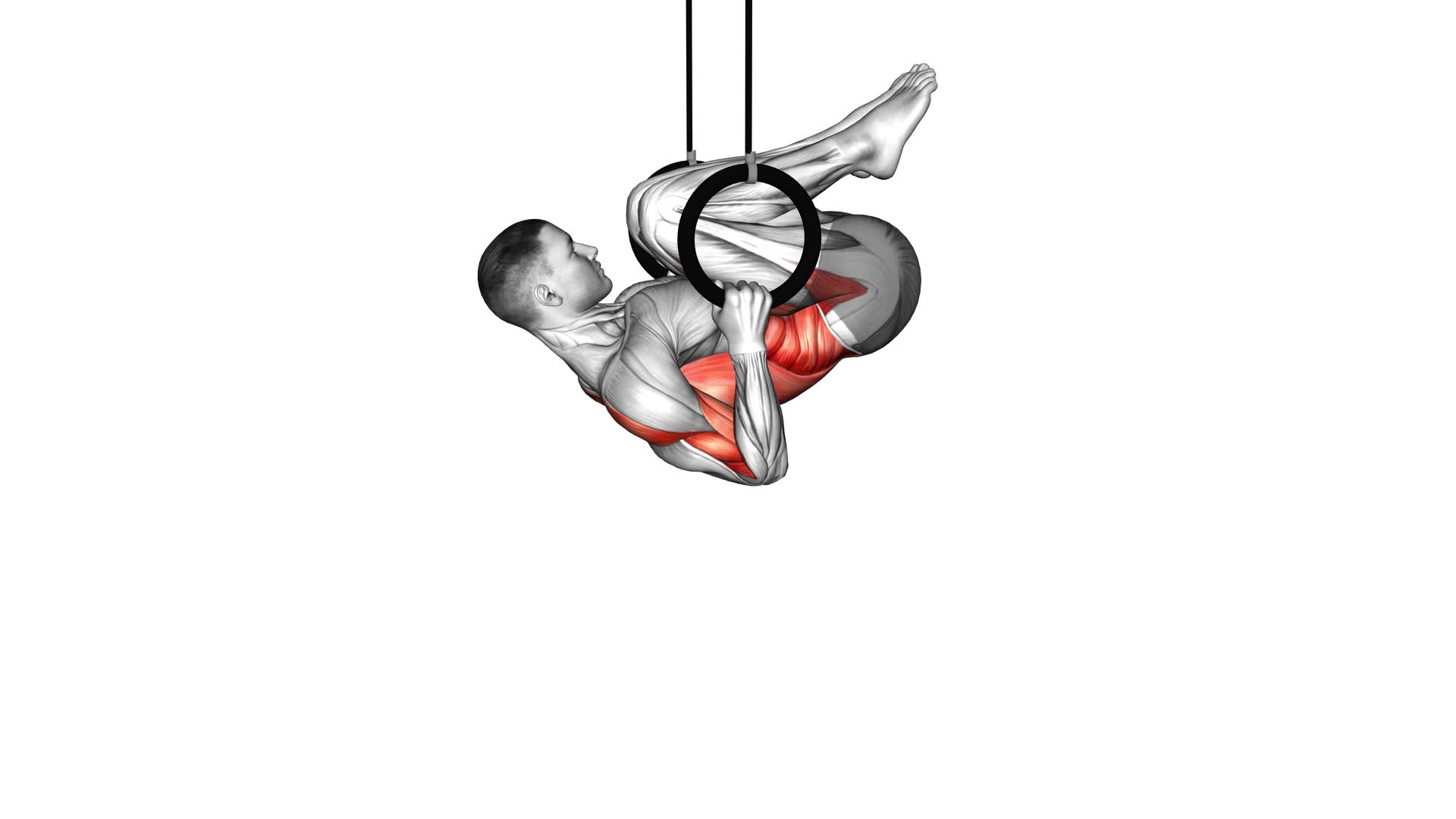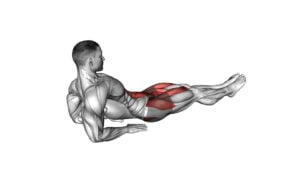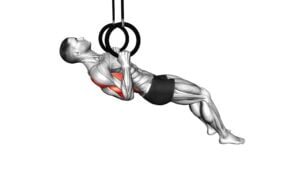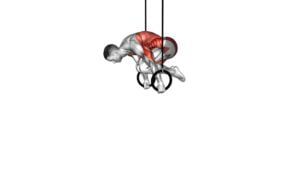Ring Knee Tuck Row (male) – Video Exercise Guide & Tips

Looking to strengthen your upper body and core? The Ring Knee Tuck Row is the perfect exercise for you. In this video exercise guide, we'll show you the proper form and technique to maximize the effectiveness of this workout.
Watch This Exercise Video
Whether you're a beginner or an advanced athlete, we've got modifications for every level. Avoid common mistakes and get the most out of your workout with our helpful tips.
Let's get started!
Key Takeaways
- The Ring Knee Tuck Row targets back muscles such as lats, rhomboids, and rear delts, improving posture and upper body strength.
- Engaging core muscles and maintaining stability and balance are important aspects of the exercise.
- The exercise can be modified for different fitness levels and goals, making it accessible for beginners and challenging for advanced athletes.
- Proper form and technique, including avoiding common mistakes, are crucial for maximizing the effectiveness of the Ring Knee Tuck Row.
Benefits of the Ring Knee Tuck Row
To fully understand the benefits of the Ring Knee Tuck Row, you need to learn about its impact on multiple muscle groups. This exercise primarily targets the back muscles, including the lats, rhomboids, and rear delts. By engaging these muscles, the Ring Knee Tuck Row helps improve posture and upper body strength.
Additionally, the Ring Knee Tuck Row also engages the core muscles. As you lift your knees towards your chest, you activate your abdominal muscles, including the rectus abdominis and obliques. This not only helps strengthen your core, but also enhances stability and balance.
One of the great things about the Ring Knee Tuck Row is that it can be modified to suit different fitness levels and goals. For beginners, you can start by performing the exercise with bent knees and gradually progress to straight legs as you build strength. You can also vary the difficulty of the exercise by adjusting the height of the rings or adding resistance bands.
Incorporating ring knee tuck row variations into your workout routine can help prevent plateaus and keep your workouts challenging and effective. Some variations include single-arm ring knee tuck row, ring knee tuck row with a twist, and ring knee tuck row with a pause at the top.
Proper Form and Technique for the Exercise
To perform the Ring Knee Tuck Row exercise with proper form and technique, you need to focus on engaging specific muscle groups and maintaining proper body alignment. Here are some key tips to help you perform this exercise correctly:
- Start by hanging from the rings with your arms fully extended and your body in a straight line.
- Engage your core muscles and pull your knees up towards your chest while simultaneously pulling your elbows back.
- Pause for a moment at the top of the movement, squeezing your shoulder blades together.
- Slowly lower your knees back down and extend your arms to return to the starting position.
Proper form and technique are crucial when performing the Ring Knee Tuck Row to prevent injuries and maximize the benefits of the exercise. It's important to avoid the following common mistakes:
- Dropping your head and rounding your shoulders, which can strain your neck and upper back.
- Using momentum to swing your body, which reduces the effectiveness of the exercise and increases the risk of injury.
- Allowing your lower back to sag or arch excessively, which puts strain on your spine.
By focusing on maintaining proper form and technique, you can effectively target your back muscles and minimize the risk of injury.
Remember to start with lighter resistance and gradually progress to more challenging variations as you gain strength and confidence.
Modifications for Beginners and Advanced Athletes
For beginners, a modified version of the Ring Knee Tuck Row can be performed with less resistance or by using a stable surface for support. To decrease resistance, you can adjust the height of the rings, making it easier to pull yourself up. This modification allows you to gradually build strength and progress to the full exercise.
Additionally, beginners can use a stable surface such as a bench or box to support their feet during the exercise. This provides extra stability and helps maintain proper form while performing the movement.
On the other hand, advanced athletes can make modifications to increase the difficulty of the Ring Knee Tuck Row. One way to challenge yourself is by adding weight to your body. You can do this by wearing a weighted vest or holding a dumbbell between your feet.
Another progression for advanced athletes is to perform the exercise with straight legs instead of tucking the knees. This engages the core and upper body muscles even more, making the exercise more challenging. Additionally, you can experiment with different grips, such as an overhand or underhand grip, to target different muscle groups.
Remember to always listen to your body and progress at a pace that feels comfortable and safe for you.
Common Mistakes to Avoid
Avoid these three common mistakes while performing the Ring Knee Tuck Row exercise:
- Improper form: One of the most common mistakes isn't maintaining proper form throughout the exercise. It's crucial to keep your back straight, engage your core, and avoid rounding your shoulders. This ensures that you target the correct muscles and minimize the risk of injury.
- Using momentum: Another mistake to avoid is relying on momentum to complete the exercise. Instead, focus on controlled movements, pulling yourself up using your back muscles, and squeezing your shoulder blades together at the top of the movement. This will maximize the effectiveness of the exercise and build strength.
- Neglecting full range of motion: Many people make the mistake of not fully extending their arms at the bottom of the movement. This limits the engagement of the back muscles and reduces the overall effectiveness of the exercise. Make sure to fully extend your arms at the bottom and pull your knees towards your chest with control.
Tips for Maximizing the Effectiveness of the Ring Knee Tuck Row
To maximize the effectiveness of the Ring Knee Tuck Row, focus on maintaining proper form, engaging your core, and utilizing controlled movements. These tips will help you get the most out of this exercise and continue making progress.
First, it's important to maintain proper form throughout the movement. Start by gripping the rings firmly with your palms facing each other. Keep your body in a straight line from head to toe, engaging your core to stabilize yourself. As you pull your knees towards your chest, make sure to keep your elbows close to your sides and squeeze your shoulder blades together. This will help target your back muscles effectively.
Engaging your core is crucial for stability and generating power. By tightening your abdominal muscles, you create a solid foundation for your upper body to pull against. This will also help protect your lower back from unnecessary strain.
To progress in the Ring Knee Tuck Row, you can try different variations of the exercise. Once you have mastered the basic movement, you can increase the difficulty by raising your feet higher, eventually aiming to bring your knees all the way to your chest. You can also experiment with different grips, such as a neutral grip or an overhand grip, to target your muscles from different angles.
Remember to always prioritize form and control over quantity. By focusing on these tips, you'll maximize the effectiveness of the Ring Knee Tuck Row and continue challenging your muscles for continued progress.
Frequently Asked Questions
What Are the Different Variations of the Ring Knee Tuck Row?
There are several different variations of the ring knee tuck row. These variations allow you to target different muscles and add variety to your workout.
Some common variations include single-arm knee tuck rows, wide-grip knee tuck rows, and elevated knee tuck rows.
Each variation has its own benefits and modifications to suit different fitness levels and goals.
Incorporating these variations can help you build strength and improve your overall upper body and core stability.
How Many Sets and Reps Should I Perform for the Ring Knee Tuck Row?
For optimal training frequency for the ring knee tuck row, it's recommended to perform this exercise 2-3 times per week.
Start with 2 sets of 8-12 reps, and gradually increase the number of sets and reps as you progress.
Progression strategies for the ring knee tuck row include increasing the intensity by adding weight or performing more challenging variations, such as the leg extended ring row.
Remember to listen to your body and adjust the sets and reps based on your individual fitness level and goals.
Can I Incorporate the Ring Knee Tuck Row Into a Full-Body Workout Routine?
Yes, you can definitely incorporate the ring knee tuck row into a full-body workout routine.
This exercise offers numerous benefits for core strength and stability. By engaging your core muscles, you improve balance and enhance overall body control.
Additionally, the ring knee tuck row targets your back, arms, and shoulders, making it an effective compound exercise.
Including this movement in your routine will help you achieve a well-rounded and challenging workout.
Is It Necessary to Use Rings for the Ring Knee Tuck Row, or Can I Use Other Equipment?
It's not necessary to use rings for the ring knee tuck row, but they offer unique benefits. Rings provide instability, challenging your core and upper body more.
However, you can use other equipment like a suspension trainer or a barbell on a Smith machine. These alternatives may not engage your muscles as effectively as rings, but they still offer a good workout.
Ultimately, it's up to your preference and equipment availability.
How Long Does It Take to See Results From Regularly Performing the Ring Knee Tuck Row?
To track progress from regularly doing the ring knee tuck row, pay attention to how your body feels and the number of reps you can do.
Results vary, but you may start to notice changes in strength and muscle tone after a few weeks of consistent training.
Be sure to avoid common mistakes like using momentum or not engaging your core.
Stay focused and committed, and you'll see improvements over time.
Conclusion
In conclusion, the ring knee tuck row is a beneficial exercise for both beginners and advanced athletes. By following proper form and technique, you can maximize its effectiveness. Additionally, modifications can be made to suit your fitness level.
Avoiding common mistakes will help prevent injuries and ensure optimal results. Incorporate the ring knee tuck row into your workout routine to strengthen your upper body, core, and improve overall fitness.

Author
Years ago, the spark of my life’s passion ignited in my mind the moment I stepped into the local gym for the first time. The inaugural bead of perspiration, the initial endeavor, the very first surge of endorphins, and a sense of pride that washed over me post-workout marked the beginning of my deep-seated interest in strength sports, fitness, and sports nutrition. This very curiosity blossomed rapidly into a profound fascination, propelling me to earn a Master’s degree in Physical Education from the Academy of Physical Education in Krakow, followed by a Sports Manager diploma from the Jagiellonian University. My journey of growth led me to gain more specialized qualifications, such as being a certified personal trainer with a focus on sports dietetics, a lifeguard, and an instructor for wellness and corrective gymnastics. Theoretical knowledge paired seamlessly with practical experience, reinforcing my belief that the transformation of individuals under my guidance was also a reflection of my personal growth. This belief holds true even today. Each day, I strive to push the boundaries and explore new realms. These realms gently elevate me to greater heights. The unique combination of passion for my field and the continuous quest for growth fuels my drive to break new ground.



